The 2024 Olympia will mark the 60th anniversary of bodybuilding’s most prestigious contest. From once vying for a spot at the Olympics to turning into a super-niche sport, this journey has been nothing but remarkable.
Twenty-one athletes have been crowned Mr. Olympia since the Weider brothers hosted the first competition in 1965. The Mr. Olympia champ earns the bragging rights to call themselves the best bodybuilder in the world and takes home a hefty paycheck — the 2023 Mr. Olympia Derek Lunsford won a whopping $400,000.
The Mr. Olympia contest has seen its fair share of ups and downs. The ownership has changed hands multiple times, and several controversies, including athlete safety and alleged drug use, have surrounded it. However, none of this has stopped the athletes from pushing their bodies to the absolute limits in pursuit of the elusive Sandow trophy.
The athlete’s physiques have undergone major changes over the years, setting new standards for athletes worldwide. In this article, I compare all Mr. Olympia winners and delve into how their physiques have evolved over the decades.
Mr. Olympia Winner Physique Evolution Over Six Decades
Analyzing how the physiques have changed over the years provides valuable insights into the future trajectory of the sport. The IFBB Pro League judges can steer the athletes’ physiques in the direction they want by demarking those who don’t align with their vision of the ideal physique.
First Decade: 3 Champions
- Larry Scott (1965-66)
- Sergio Oliva (1967-69)
- Arnold Schwarzenegger (1970-75)
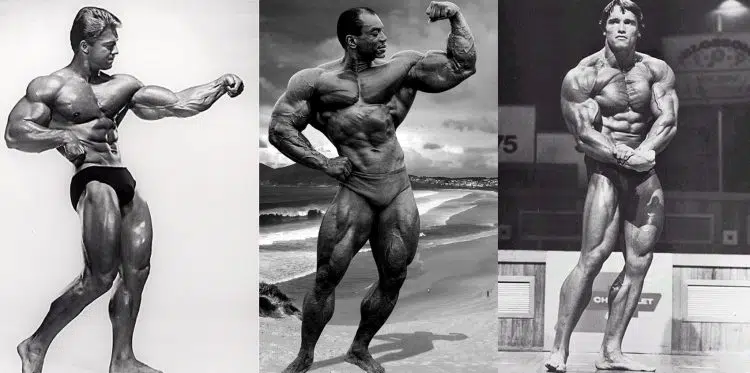
The period between the 1960s and 1980s is dubbed the ‘Golden Era of Bodybuilding,’ a time when the focus was on symmetry, proportion, and overall physique aesthetic instead of simply getting as big and muscular as possible.
Level Up Your Fitness: Join our 💪 strong community in Fitness Volt Newsletter. Get daily inspiration, expert-backed workouts, nutrition tips, the latest in strength sports, and the support you need to reach your goals. Subscribe for free!
Larry Scott won the inaugural Mr. Olympia contest thanks to his impeccable shoulders and arms and repeated the feat the following year before announcing his retirement. Scott was the only Mr. Olympia champ to have never lost an Olympia competition.
When everyone thought they had witnessed the world’s best arms, Sergio Oliva came to the 1967 Olympia with immense improvements. Oliva’s wide frame, giant arm, and sprawling quads separated him from his competition and helped him snag his first of two Olympia gold medals.
The young Austrian bodybuilder Arnold Schwarzenegger debuted at the Mr. Olympia in 1969 but had to settle for second place behind Oliva. He fixed the gaps in his physique the next year and dethroned “The Myth” to win his first Mr. Olympia title. Arnie has since become the poster boy of physique aesthetics.
“The Austrian Oak” hung up his posing trunks after claiming his sixth consecutive Mr. Olympia victory. No one could have asked for a better first decade for Mr. Olympia.
Second Decade: 6 Champions
- Franco Columbu (1976 & 1981)
- Frank Zane (1977-79)
- Arnold Schwarzenegger (1980)
- Chris Dickerson (1982)
- Samir Bannout (1983)
- Lee Haney (1984-91)
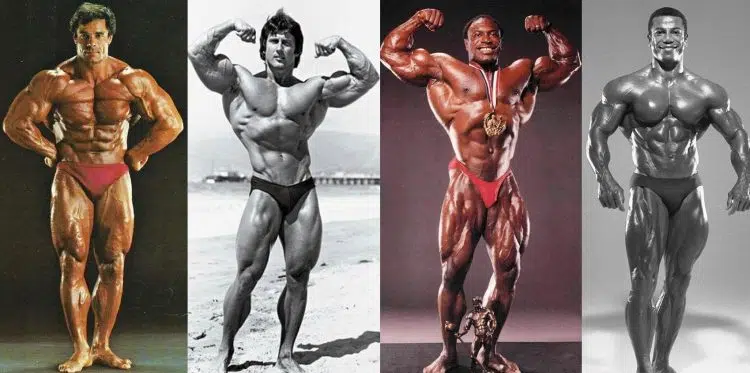
The Mr. Olympia throne was anyone’s for the taking after Schwarzenegger retired. The second decade saw six champions get crowned in 10 years.
Arnie’s best friend, Franco Columbu, earned the throne after he left. It was also a significant shift in terms of the types of physiques. While Arnold stood at 6-foot-1, Columbu was 5-foot-5, making him the shortest Mr. Olympia winner of all time.
The 1977 Mr. Olympia was a big year for the show. While all the previous winners were very muscular, Zane prioritized his physique symmetry, balance, lines, muscle separation, and definition.
Schwarzenegger ended Zane’s three-year reign in one of the most controversial Mr. Olympia showdowns of all time. Legendary bodybuilder Mike Mentzer retired after the 1980 Olympia, citing favoritism and unfair judging practices. Nonetheless, Arnold’s win in 1980 concluded the Golden Era.
Chris Dickerson’s 1982 Mr. Olympia victory was a huge milestone as he was the first African-American and openly gay bodybuilder to win the coveted Sandow trophy. Like Columbu, Dickerson was of shorter stature (5-foot-6) and capitalized on his physique symmetry, definition, and shape to overpower his competition.
Samir Bannout’s victory at the 1983 Olympia was a surprise to most. Bannout’s dense and thick physique separated him from the pack and made him the first Middle Eastern bodybuilder to win the Olympia crown. The most interesting of all, this was Bannout’s first pro show victory.
Most bodybuilding pundits believed that Arnold’s seven Olympia wins would be hard to beat. However, Lee Haney proved all of them wrong and concluded the second decade by starting one of the most dominant reigns in Olympia’s history.
Third Decade: 2 Champions
- Lee Haney (1984-91)
- Dorian Yates (1992-97)

Haney overshadowed his peers with his size and is credited with starting the size game in bodybuilding. He kept getting bigger and more diced every year and became the first bodybuilder in history to win eight consecutive Mr. Olympia wins.
Haney retired from competitive bodybuilding after the 1991 Olympia. His era made one thing very clear — size was one of the biggest factors in winning the Mr. Olympia.
This was proven once again when British bodybuilder Dorian Yates stepped on the 1992 Olympia stage with his monstrous size and definition. While Haney brought size to the mainstream, Yates started the ‘Mass Monster’ era.
Some bodybuilding experts opine that although Yates didn’t have the most balanced or symmetrical physique, his immense size and razor-sharp conditioning ensured he was undeniable in every show he entered. What’s even more crazy is that Yates won the 1997 Olympia with a torn tricep.
Fourth Decade: 2 Champion
- Dorian Yates (1992-97)
- Ronnie Coleman (1998-2005)
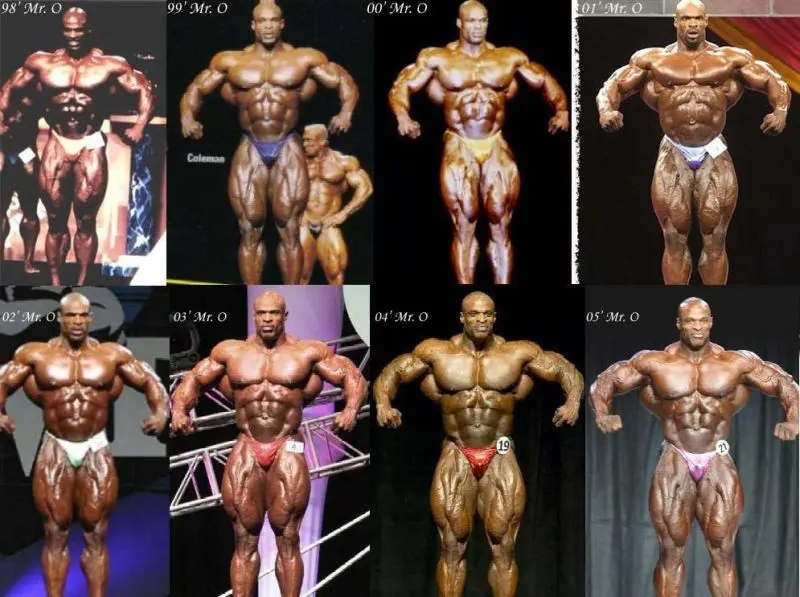
Yates continued his dominance into the fourth decade of the O and won six consecutive Mr. Olympia titles. Just when everyone thought Yates would be the biggest bodybuilder ever to grace the stage, Ronnie Coleman surprised everyone by winning the 1998 Mr. Olympia by besting Flex Wheeler.
Level Up Your Fitness: Join our 💪 strong community in Fitness Volt Newsletter. Get daily inspiration, expert-backed workouts, nutrition tips, the latest in strength sports, and the support you need to reach your goals. Subscribe for free!
Coleman’s win reinstated that even though aesthetics, symmetry, and balance were highly appreciated, size and conditioning were still king.
Coleman’s era is regarded as the most competitive of all time. Elite athletes like Flex Wheeler, Kevin Levrone, Nasser El Sonbaty, Chris Cormier, Jay Cutler, Dexter Jackson, and Gustavo Badell locked horns for the top spot at the Olympia each year, but Coleman came out on top each time.
The sport of bodybuilding witnessed significant advancements in training techniques, nutrition, and supplementation around the same time. This helped athletes get bigger and more conditioned each year.
Coleman was arguably the first bodybuilder to capitalize on his fame. He recorded his famous training videos during his Olympia reign, where he performed some mind-boggling lifts. These training videos sold like hotcakes and turned Coleman into one of the most popular bodybuilders of all time.
Coleman eventually matched Haney’s record of eight consecutive Olympia titles. However, his relentless pursuit of size began to take a toll on his physique towards the end of his reign. Competitive bodybuilders were criticized for compromising aesthetics in favor of sheer muscle mass.
The infamous protruding bellies had become a common sight in bodybuilding shows during this era.
Fifth Decade: 3 Champions
- Jay Cutler (2006-07 & 2009-10)
- Dexter Jackson (2008)
- Phil Heath (2011-17)
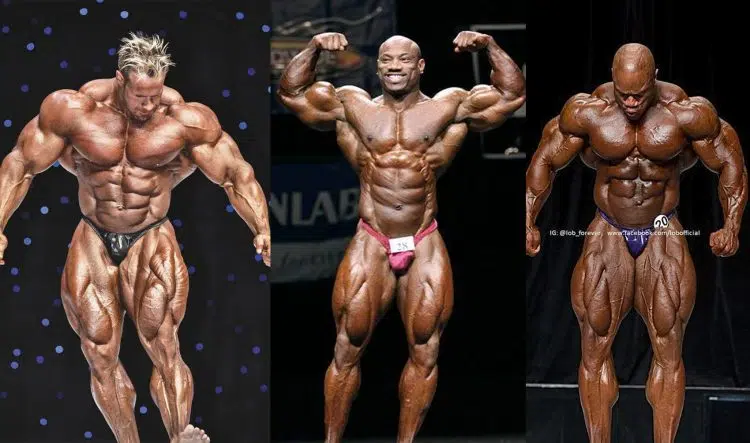
After four runner-up finishes at the Olympia, Cutler finally broke Coleman’s vice-like grip on the Sandow trophy in 2006. The secret, you ask? More size!
However, judges took stock of the situation and decided to make amends. Cutler lost his Olympia throne to a much smaller but more conditioned and well-balanced Dexter Jackson in 2008. This sent shockwaves throughout the pro bodybuilding circuit, forcing athletes and coaches to rethink their strategies.
Cutler returned to the drawing board after this defeat and came back in 2009 with a much more balanced, symmetrical, and conditioned physique, which helped him reclaim the Olympia title. This win etched Cutler’s name in the annals of bodybuilding as the only Mr. Olympia champ to win the Sandow trophy after losing it.
Right before Cutler could begin another mass monster era, Phil Heath grabbed his first Mr. Olympia title in 2011. Health earned the moniker ‘The Gift’ for his incredible genetics. He had the perfect blend of size, definition, symmetry, and balance that helped him close the door on his opponents in every show.
Health and Kai Greene’s rivalry is one of the most iconic clashes in bodybuilding history. They traded barbs on stage and even came close to a fistfight at the 2014 Mr. Olympia. Greene and Kai were the main leads in Generation Iron (2013), a bodybuilding documentary chronicling their epic rivalry.
Sixth Decade: 6 Champions
- Phil Heath (2011-17)
- Shawn Rhoden (2018)
- Brandon Curry (2019)
- Mamdouh “Big Ramy” Elssbiay (2020-21)
- Hadi Choopan (2022)
- Derek Lunsford (2023)
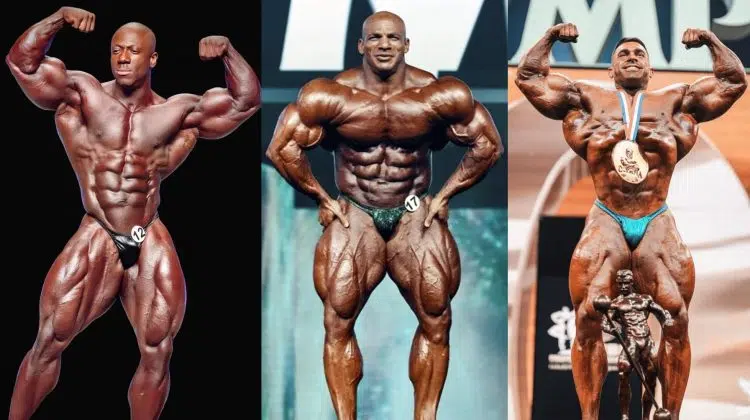
Heath struggled with hernia issues in 2017 and 2018 and ended up losing his title to Shawn Rhoden in 2018. This was another sign that the pro bodybuilding world was prioritizing aesthetics.
Rhoden was barred from defending his Olympia throne at the 2018 Olympia due to pending legal charges. American bodybuilder Brandon Curry turned up with his all-time best symmetry and conditioning, which helped him become the 15th bodybuilder to win the Mr. Olympia title.
Many bodybuilding journalists also consider the years between 2018 and 2021 to be a cooling period for the bodybuilding circuit. The lineups weren’t as stacked as they used to be, and there were no major rivalries.
However, Mamdouh “Big Ramy” Elssbiay shook up the order at the 2020 Mr. Olympia with his trademark size and won his maiden Sandow trophy. Curry finished second, while seven-time champion Heath had to settle for a third place.
The bodybuilding world was abuzz with speculations about whether we were headed back to the mass monster era. Ramy’s second win at the 2021 Olympia seemed to confirm these suspicions.
Former 212 division bodybuilder Hadi Choopan pacified these beliefs when he won the Mr. Olympia title in 2022, beating a highly competitive roster of 30 athletes. Choopan is known for his full and round muscle bellies and incredible muscle conditioning.
With Choopan in the saddle, conditioning, aesthetics, symmetry, and balance were once again at the forefront.
This prompted the 2021 212 Olympia champion, Derek Lunsford, to switch to the Open division and challenge Choopan. Lunsford’s move paid off big time as he became the first-ever multi-division Olympia champ in the sport’s history by beating Hadi Choopan.
Wrapping Up
One could consider the sixth decade of Mr. Olympia the most turbulent time in the show’s history. At the time of writing, six different bodybuilders have won the Sandow trophy in the last nine years, and we still have one year to go.
Who do you think will win the Olympia title in 2024? Will Lunsford do a repeat, or will Choopan become the second bodybuilder to reclaim the Sandow trophy after losing it? Or do you think Samson Dauda, Nick Walker, or Andrew Jacked will take the cake this year?
Drop your predictions in the comments section below. Also, are you a fan of the mass monsters, or do you prefer aesthetics?








